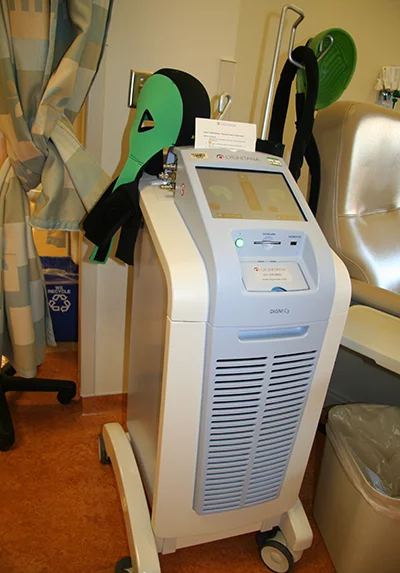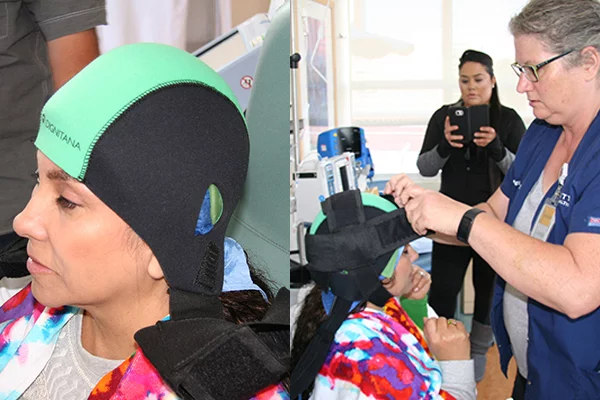One day last May, cancer turned the tables on Phyllis Sanchez.

Sanchez is a mammographer at University of New Mexico’s Outpatient Surgery and Imaging Services in Albuquerque. On her 56th birthday, she moved to the other side of the imaging machine to receive 3-D mammography. The mammogram results raised suspicions. Sanchez stayed at the hospital for an ultrasound and biopsy. A day normally reserved for celebration turned somber. Not long after, Sanchez received a diagnosis of breast cancer.
A provider suddenly turned patient, Sanchez took hope from the fact that she had caught the cancer at stage 1, grade 1. The tumor is slightly larger than a centimeter and has not spread to the lymph nodes. She’s now halfway through a regimen of four chemotherapy treatments at University of Colorado Cancer Center that is the first step in trying to stop the cancer in its tracks.

Sanchez is also attempting to rewrite the signature side effect of chemo: hair loss. Before her infusions, she dons a fitted silicone cap connected to an automated control unit that delivers temperature-regulated coolant to her scalp. Gradually chilling the scalp slows the flow of blood carrying drugs that are toxic – not only to her tumor but also to her hair follicles. In a colder environment, hair cells also divide less frequently, making for fewer pathways for the drugs. The greater the number of healthy hair follicles, the greater the amount of hair she might preserve.
The DigniCap® system, from Dallas, Texas-based Dignitana, Inc., is the first scalp-cooling treatment for chemo-induced hair loss approved by the FDA to help reduce the side effects of chemotherapy-induced hair loss in women with breast cancer, said Virginia Borges, MD, deputy division head for Medical Oncology at the University of Colorado School of Medicine. Borges led the effort to bring the new technology to UCH, which became the first in the state to offer it Aug. 1. All told, the DigniCap is now available at about two dozen hospitals in 15 states. Those closest to Colorado are in Kansas and Texas.
For Sanchez, minimizing chemo-induced hair loss is an important push-back against her disease. “I might have cancer, but I don’t want to look like it,” she said.
Capping the chemo
Two machines are now in operation in the Infusion Center at UCH, offering treatment to up to four women per day. A third machine is in place at the Lone Tree Health Center, Borges said. In addition to Sanchez, a dozen patients were lined up to use the DigniCap as of the end of August, she added.
A couple of weeks after her first treatment, Sanchez said she’d lost only “a few tangles” of her long brown locks. She knows that the DigniCap won’t completely prevent hair loss, but she hopes it will keep chemo’s assault on her scalp at bay.
“I want to preserve as much hair as I can evenly. I don’t want it to come out in patches,” she said.
She freely admits how much her hair means to her. “I’ve never had short hair in my life,” she said on a recent afternoon as she sat in a Breast Center exam room with daughter Monica following a pre-infusion visit with her medical oncologist, Peter Kabos, MD.

“As a woman, hair is everything,” Monica added.
But it’s more than vanity that motivates Sanchez to keep as much of her hair as she can. She also wants to serve as an example for other women who might avoid getting a mammogram because they fear what they might find. The physical challenges of treatment are formidable, but hair loss is also a stark and long-term reminder of the disease and the toll it takes. In addition, Taxotere, the chemo drug most commonly used for breast cancer patients, including Sanchez, has been linked to permanent hair loss in a relatively small but significant number of cases. That can be another deterrent to seeking care, she said.
“I want women to have hope when they get a mammogram,” Sanchez said. “So many don’t even want to admit that they have found a lump.”
Hair prep

The DigniCap is neither the first nor the only scalp-cooling system for preventing chemo-induced hair loss. The approach has been around for more than 40 years, and there are a variety of products on the market. The Cold Cap, for example, has been used at the Cancer Center for several years. But it is a cumbersome manual system that requires multiple fittings of frozen caps during a single chemotherapy session. And because the Cold Cap is not FDA approved, staff in the Cancer Center cannot offer any assistance to patients who use it. Nurses in the Infusion Center, on the other hand, have received the training to help patients with the DigniCap and program the automated machine.
After Sanchez’s diagnosis, Monica began helping her research the options for reducing hair loss during chemo treatment. She found the Rapunzel Project, a nonprofit founded by two breast cancer survivors, which provided guidance. Sanchez said she wanted the DigniCap primarily because of its FDA approval. While it’s not offered yet at the University of New Mexico, she got the go-ahead from her insurance provider to get out-of-network treatment at UCH.
Making the most of the DigniCap requires some effort. For her second chemo session Aug. 31, Sanchez sat in a reclining chair in a sunny Infusion Center bay about 30 minutes before the chemo treatment began. Monica wet her hair to get it flat and straight for a snug fit for the silicone cooling cap, stroking through it with a wide-toothed comb to avoid pulling out hair.
When Monica finished, Infusion Center nurse Vicki Slat-Vasquez, RN, tucked Sanchez’s hair under a blue covering, then pulled on the specially fitted green DigniCap. With the DigniCap snugly in place, Vasquez put a synthetic rubber covering over it for an even tighter fit – the better to keep out air and preserve a low temperature during the chemo. Vasquez secured it all with Velcro straps under the chin and across the top of the head. She hooked the cap’s connectors to the automated machine, tapped a small screen to program it, and coolant began flowing into the cap.
Cold facts
Within a few minutes, the temperature of Sanchez’s scalp had dropped about 10 degrees on the Fahrenheit scale. The temperature falls gradually, and a sensor in the DigniCap prevents it from dipping below freezing.

Vasquez set the cooling period for 15 minutes before the start of Sanchez’s infusion, but that time can be adjusted upward if the scalp gets uncomfortably cold too quickly. “Everybody’s head is a little different,” she said.
“How does it feel in back?” Sanchez’s husband Richard asked.
“It’s pretty cold, I can tell you that,” she replied.
She said she was uncomfortably cold at times during the first treatment, and was prepared with an electric blanket to ward off the chill. She’d need warmth because the process is lengthy. The chemo infusion itself takes about four hours, and the DigniCap stays on for two hours more afterward for a gradual warm-up.
As this new technology rolls out, an obstacle to offering the DigniCap to more women is cost, Borges said, but added the hospital is committed to offsetting some of the expense, which runs less than $100 per session. For example, some of the proceeds from this year’s Men for the Cure event, which raises money for the Diane O’Connor Thompson Breast Center, will go toward helping women pay for DigniCap treatments.

After completing her chemotherapy regimen, Sanchez said she’ll need radiation therapy in New Mexico, then five years of oral Tamoxifen or another hormone therapy. She said Kabos has worked closely with her oncologist at home, helping to make a difficult experience as comfortable as possible.
She’ll continue tending to her hair over the next several weeks. Between chemo sessions, she must stick to baby shampoo and warm water while shunning conditioners and hair dryers. Every strand her mother preserves will be important in telling women to fight back against cancer, Monica said.
“Who better to tell this story than my mom – a positive, strong woman,” she said.
